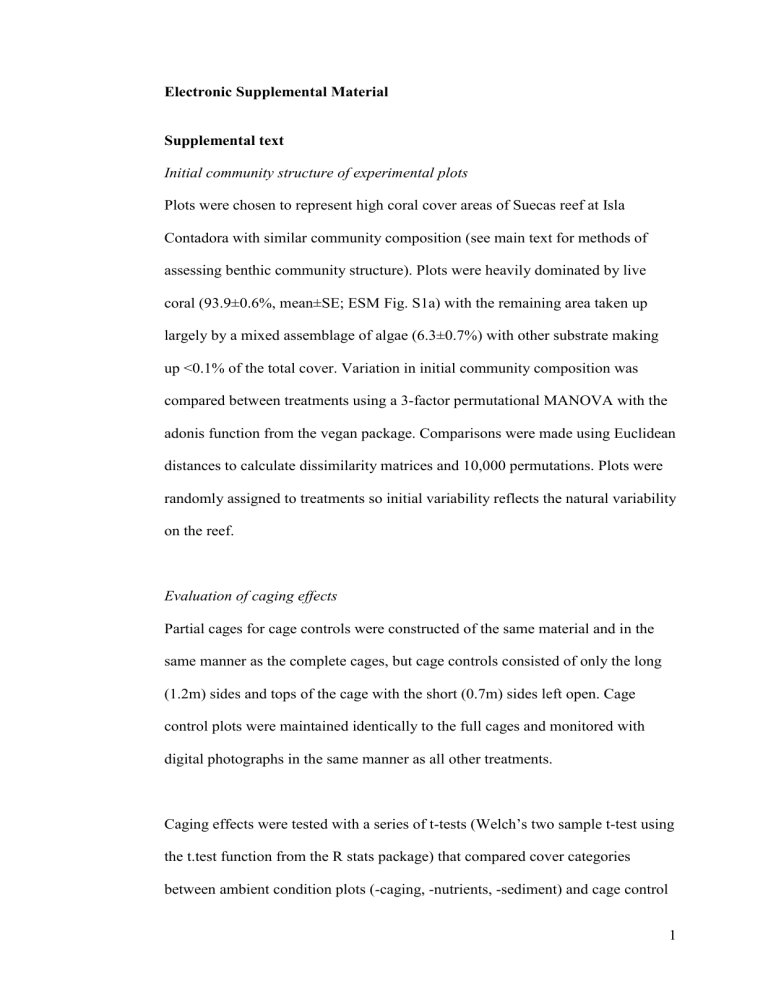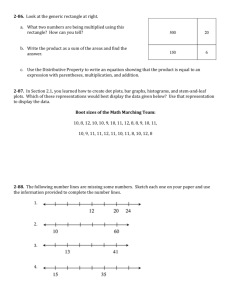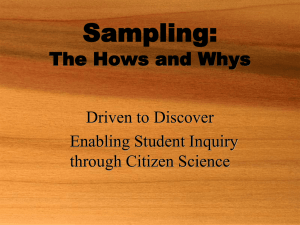Author template for journal articles

Electronic Supplemental Material
Supplemental text
Initial community structure of experimental plots
Plots were chosen to represent high coral cover areas of Suecas reef at Isla
Contadora with similar community composition (see main text for methods of assessing benthic community structure). Plots were heavily dominated by live coral (93.9±0.6%, mean±SE; ESM Fig. S1a) with the remaining area taken up largely by a mixed assemblage of algae (6.3±0.7%) with other substrate making up <0.1% of the total cover. Variation in initial community composition was compared between treatments using a 3-factor permutational MANOVA with the adonis function from the vegan package. Comparisons were made using Euclidean distances to calculate dissimilarity matrices and 10,000 permutations. Plots were randomly assigned to treatments so initial variability reflects the natural variability on the reef.
Evaluation of caging effects
Partial cages for cage controls were constructed of the same material and in the same manner as the complete cages, but cage controls consisted of only the long
(1.2m) sides and tops of the cage with the short (0.7m) sides left open. Cage control plots were maintained identically to the full cages and monitored with digital photographs in the same manner as all other treatments.
Caging effects were tested with a series of t-tests (Welch’s two sample t-test using the t.test function from the R stats package) that compared cover categories between ambient condition plots (-caging, -nutrients, -sediment) and cage control
1
plots (+partial cages, -nutrients, -sediment). Separate tests compared percent cover of each benthic community member (coral, macroalgae, turf algae, and CCA) between the cage control plots and the ambient condition plots for each of the five time points measured. No significant differences were seen for any community member at any time point (Table S2) so caging effects were assumed to be minimal.
Evaluation of effectiveness of caging treatment
To evaluate the effectiveness of cages at reducing herbivory we conducted a separate experiment to measure the reduction in herbivory by herbivore exclosure cages. To do this we measured rates of herbivory in two caged (+caging, nutrients, -sediment plots and two open (-caging, -nutrients, -sediment) plots. For the bioassays, we outplanted caged and uncaged thalli of a palatable red macroalga from the genus Laurencia into the appropriate plots and measured consumption over 24 hr in November 2008. Algae were collected from an adjacent reef, cleaned of sediment, invertebrates and epiphytes, spun in a salad spinner at a constant rate for 1 minute, then cable-tied into 3 g bundles. To estimate algal growth and control for handling losses, half of the bundles were protected from herbivory by cylindrical cages made of plastic hardware cloth (10 cm diameter x 15 cm height, 1.3 cm mesh size, which is smaller than the mesh size of the treatment cages and which we have previously established as effective for excluding herbivores). Assays were deployed on lines anchored in the appropriate plots with open and caged algal bundles attached haphazardly ~25-50 cm apart. Replication was six-fold for each treatment (equally split between the two caged or uncaged plots), except for the growth control samples in the open plots, which had only four replicates. After 24 hr, each bundle was collected,
2
spun, and reweighed. In the open plots many samples were completely consumed, which produced a conservative estimate of consumption rate, but still provided relative measures between treatments.
To determine herbivory rates, we adjusted for the net effect of handling losses and algal growth using the change in biomass of caged samples for each treatment.
However changes in the caged samples were largely negligible averaging 0.1 g lost in the open plots and no change in the herbivore exclosure plots. Herbivory rates were calculated by subtracting the average change in biomass of caged samples from the change in biomass of open samples. The data were tested for normality and homogeneity of variances to meet the assumptions of parametric statistics. Herbivory rates were compared between treatments using a t-test (with the t.test function from the stats package in R.
Herbivore exclosures strongly reduced rates of algal consumption compared to uncaged plots (t=-3.671, df=9.87, p=.004). While algal losses did occur within herbivore exclosures, it was reduced by ~75% to 0.567
0.320 g d -1 lost (mean
SE, ESM Fig S2) from 2.333
0.359 g d -1 lost in open plots
Evaluation of the effectiveness of the nutrient enrichment treatment
The effectiveness of nutrient enrichment was evaluated by collecting seawater from within and outside of nutrient enrichment plots and analyzing their nutrient content (following Wartian 2006). Samples were collected in November 2008 during the non-upwelling season. Three samples were taken at each of four nutrient enrichment plots with samples collected from directly above the nutrient diffuser and from 2 m shoreward of the nutrient diffuser. Samples were collected
24 hr after deployment of nutrient diffusers and by opening empty acid-washed
3
125 mL Nalgene bottles within 2 cm of the reef surface. Water samples were placed in a refrigerator in the dark while waiting to be processed and then filtered through a GF/C Whatman glass microfiber filter using a handpump. After filtration, samples were kept frozen until they were analyzed at the UC Davis
Analytical laboratory for total N (via total combustion method, which measures all forms of nitrogen, both organic and inorganic, by conversion into nitric oxide, which is then measured with a chemiluminescent detector). Data were analyzed using a mixed-effects model with distance (0 vs 2 m) as a fixed effect and plot as a random effect (using the lme function from the nlme package in R).
Water column levels of total N were almost two times higher at the nutrient diffusers (27
7
mol L
-1
; ESM Fig. S3) than 2 m away (14
0.7
mol L
-1
) with the
2 m samples similar to ambient non-upwelling conditions measured in the Gulf of
Panama (D’Croz and O’Dea 2007). This difference was statistically significant
(fixed effect of distance: df =19, t =3.14, p <.0001; random intercept SD=0.10) indicating that our manipulations were able to raise nutrient supply in nutrient enrichment plots.
Supplemental figure legends
Figure S1. Percent cover of different substrate types across treatments at each time point. Different colors represent different substrate types: gold=coral, green=macroalgae, brown=turf algae, pink=CCA, grey=sediment.
Figure S2. Herbivory rates measured in caged and uncaged plots to measure the effectiveness of herbivore exclosures.
4
Figure S3. Nutrient levels measured from water collected within nutrient enrichment plots (0 m) and outside of plots (2 m).
Supplemental tables
Table S1.
Results of multivariate 3-factor permutational MANOVA comparing initial benthic composition between treatments. Analysis was done using change in percent cover of coral, macroalgae, turf algae, and CCA as multiple response variables. Analyses were done using Euclidean distances and results are based on
10,000 permutations.
3-factor PERMANOVA on initial community composition
Factor df pseudo-F P
Caging
Nutrients
Sediment
Caging x Nutrients
Caging x Sediment
Nutrients x Sediment
Caging x Nutrients x Sediment
1
1
1
1
1
1
1
0.62 0.553
0.60 0.566
0.43 0.680
0.77 0.467
2.19 0.115
1.33 0.256
1.71 0.171
Table S2.
T-test comparing percent cover of each benthic community member between ambient condition plots and cage control plots for different time points. a) Initial time point
Community member df T
Coral
Macroalgae
Turf algae
CCA
3.72
P
1.73 0.163
3.10 -1.79 0.168
6.33 -0.51 0.626
4.49 1.38 0.232 b) Week 6
Community member df
Coral
Macroalgae
Turf algae
4.38
T P
1.35 0.243
3.31 -1.39 0.251
4.94 -0.01 0.996
5
CCA 4.37 -0.72 0.508 c) Week 12
Community member df T
Coral
Macroalgae
Turf algae
CCA
3.55
P
1.24 0.292
3.13 -1.02 0.381
4.87 -0.03 0.974
4.36 -0.60 0.581 d) Week 18
Community member df T
Coral
Macroalgae
Turf algae
CCA
P
4.87 0.94 0.390
3.95 -0.36 0.734
3.61 -0.27 0.358
6.76 -0.44 0.675 e) Week 24
Community member df T
Coral 6.37
P
0.02 0.986
Macroalgae
Turf algae
CCA
6.61 0.04 0.973
6.94 -0.27 0.796
3.00 -1.64 0.199
6





